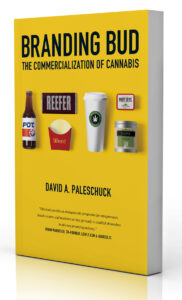While all brands are bound to play within the rules and regulations of their respective states and municipalities, they must seek creative ways to make the laws work best for their businesses and be more creative than their competitors in order to succeed.
The primary critical success factor is consistency. A readily available product with a consistent look, feel, dose, and flavor is crucial. While consistency might sound inflexible, it is not meant to be. Through consistency, one can better chart a brand roadmap that suits the company’s and customers’ needs. The cannabis sector is forever shifting; the fewer moving parts in the equation, the easier it is to contain and control the variables.

Calling out specific attributes is difficult, as cannaproducts cross a wide range of form factors, demographics, and usage scenarios. Why do we expect to see cannabis-infused edibles packaged like other baked goods and candies? Or cannabis-infused transdermal patches packaged like Band-Aids? Or cannabis-infused sublingual slips packaged like Listerine breath strips? Because we have preconceived notions about brands and their products, how they’re packaged, and under what circumstances we use them. A child-resistant cap or tamper-proof package immediately puts us at ease and makes us feel assured about our safety and consumption.
Brands can be grouped into archetypes based on key factors like the messages they use, the personality they present, and their target market. In a world where appropriation and mashups abound, it’s no surprise brand archetypes often overlap and are not mutually exclusive. In fact, many brands span one or more categories.
Here are the fourteen most prominent cannabis brand archetypes.
1. Counterculture
Counterculture brands are those that serve consumers who often define themselves and their activities through rebellion (i.e., not belonging to a conventional group). Counterculture brands simply feed the flames of consumer culture by creating a whole new set of goods for “rebel consumers.”
2. Nostalgic
Research shows nostalgia gives our lives a sense of continuity and meaning as we get older. As we age, we all develop fond memories of our younger days, from the food we ate to the games we played to the music we enjoyed. It’s no surprise many cannabis brands use nostalgia as a brand pillar.
3. Novelty
When a consumer encounters a novel image tied to a brand, they are driven to learn more about it. They compare the image to existing information: Is it new, and how does it fit into what they already know? Novelty is a powerful tool, but it’s also dangerous. The key to using novelty to attract interest is to make sure it’s a new expression of something the brand always stood for. Impeachmints, manufactured by Evergreen Herbal, is a great example of a novelty product.
4. Foodie
Understanding how farm and food relate is essential for marketing to this sought-after demographic. Marketing to foodies requires staying up to date on the latest trends across the food world. Given the increased importance everyone is placing on food, marketers would be wise to stay current. With the interconnectedness of food culture to almost everything else, the relationship with cannabis is clear.
5. Regional
A regional brand reflects the culture and qualities of a particular appellation or terroir. Examples of cannabis strains boasting their geographic origin include Maui Wowie, Durban Poison, and Acapulco Gold, to name a few. That said, it’s no surprise many brands seek to capture and leverage nuanced regional and cultural qualities.
6. Health and wellness
Health-and-wellness brands have honed their messages by putting customer well-being front and center. They typically focus on product quality, efficacy, benefits, and an overall balanced lifestyle. Brands in the health-and-wellness space do best when they provide their customers with aspirational content as well as easy access to information and tools that allow them to embrace a healthy lifestyle.
7. Celebrity
Celebrity branding is a marketing strategy that leverages a celebrity’s social status or fame to help promote a product or service. Brands use celebrities hoping the celebrity’s persona and image will “rub off on” the product(s) and/or the brand itself.
8. Prohibition
The Prohibition Era was characterized by a ban on manufacturing, storage (whether in barrels or bottles), transportation, sale, possession, and consumption of alcoholic beverages. Today, many cannabis brands connect the concept of alcohol prohibition to cannabis legalization. Examples of prohibition brands include Zoots and Lowell Herb Co., among others.
9. Art and design
The relationship between art and commerce always has been filled with anxiety. The diminishing impact of traditional advertising has caused brands to seek new ways to capture the attention of consumers. Artists and the art market have taught us how valuable a brand can become by leveraging art and artists. Seattle-based Saints Joints is a perfect example of a cannabis brand working with artists to create collectible, limited-edition box packaging.
10. Gender-focused
While statistics tell us the majority of cannabis consumers are male, the female and LGBTQ segments are an underdeveloped opportunity—possibly the number-one opportunity for those who understand how sexuality, gender, and political perspective resonate in these segments. While many have tried to “pink it and shrink it,” we certainly know that strategy hasn’t worked for brands outside the cannabis industry.
11. Value
A “budget brand” is a brand whose major selling point is its low price and/or value offering. Sometimes, but not always, that may mean lower quality. Since the COVID-19 pandemic began, there has been an increase in larger, pre-packaged product offerings such as pre-ground flower in pouches—rolling papers included.
12. Cultivator
Cultivator brands have taken off with the widespread interest in and development of strains, terpenes, and cannabinoids. Cookies is a perfect example of how a brand can grow from strain genetics. Well-known cultivators and cultivator brands also include Sherbinskis, Exotics, and Ed Rosenthal, among others.
13. Luxury
Luxury cannabis brands are those associated with high price, high quality, beauty, rarity, and perhaps even a degree of non-functionality. One of the best examples of a cannabis luxury brand is the Leira Cannagar, which Forbes magazine dubbed a “Gourmet Ultra Luxury Cannagar.”
14. Charity and social justice
People’s willingness to devote their loyalty and money to a cause is directly influenced by the positive connection they have with a brand, and vice-versa. The right image, personality, and tone of voice creates an identity to which customers (and donors) can relate, which leads to more sales and better fundraising. California’s GIVE is a great example of a cannabis charity brand.
How consumers attach themselves to a brand is based on the brand’s ability to tell its story. A health-and-wellness brand should not market its product in the same way a recreational brand focused on rebellion would. Different customer segments demand different products, whether real or perceived.
It behooves brands to creatively leverage the most recognizable brand archetype elements in order to effectively and efficiently convey who they are and what they stand for. Those brands that best differentiate and communicate will be recognized and rewarded.













